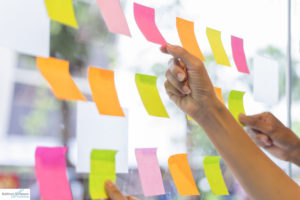As a facilitator how do you collect all the great ideas that the group you are working with have? One of my favourite tools is the ubiquitous post it note. Simply by posing a question and asking people to respond can generate many ideas. Then grouping these ideas and asking people to vote creates clear priorities before creating an action plan.
Why is this approach to brainstorming so powerful?
- It allows everyone to put forward their own ideas and thoughts without being shot down by others (especially if you agree that rule up front)
- People can write down what they think without translation by a facilitator or leader writing on a flip chart
- It levels the playing field – it’s not about the loudest voice or quickest thinker. Our introverted colleagues can be seen and heard.
- It creates a visual which aids understanding of ideas rather than relying on what has been heard (or not).
What are some ways of being even more effective?
- Go slowly – allow everyone quiet time after posing the question so that thoughtful insight can be collected. This can be challenging to do especially for impatient people who just want to move forward.

- Go anonymous – this can often free people up to speak the truth about how to solve an issue or to identify the real issue in the first place.
- Go strategically – enable understanding of all perspectives by taking the time to group and identify priorities versus debating and getting stuck in “analysis – paralysis “mode. This leads to a broader view and potentially creates more ideas and a clearer path forward.
- Go quickly – use an electronic brainstorming tool like v-wall so transcription errors are reduced, effort required to write up and quicker consolidation of results is possible. This can also have the benefit of collecting ideas remotely or before or after a work session which can be displayed to everyone involved and recorded easily. It is also much more environmentally friendly!
A Harvard article showed that incorporating these ideas i.e. giving people time to think, allowing anonymity via on line brainstorming yielded not only 70-100% more ideas but that the quality of those ideas was higher.
Any other tips for collecting and analyzing great ideas?
Acknowledgement:
To Andy Chilton and the Velresco team for developing vwall and providing feedback on this article
